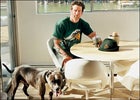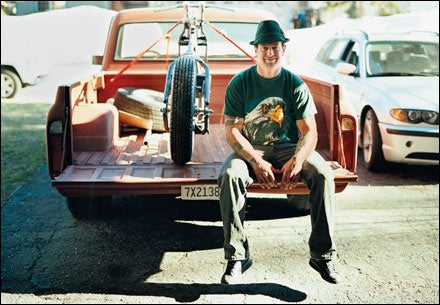RIDING A GONDOLA is like going to Vegas: Business deals are made, affairs blossom, or you run into a celebrity like Cher, except she’s wearing Kjus instead of a feather headdress. Most icons come with paparazzi, so I didn’t suspect anything extraordinary when, one evening in December 2007, a lone wolf in a puffy North Face jacket jumped into the gondola as my friend Rosie and I were on our way up to Mountain Village, above Telluride, Colorado, for dinner.
Shaun Palmer
 At home with his dog, Vinnie
At home with his dog, VinnieWe shivered in our street clothes while stealing glances at the incoming stranger: He was about 40, had a little chin stubble, was approximately five-eight, attractive, and appeared to be very fit. Taking advantage of the 2:1 ratio, Rosie and I struck up a game of 20 Questions. Lone Wolf, who seemed shy and had a soft twang, stepped up.
First question: Skier or snowboarder?
Both. But a few years ago, Lone Wolf told us, he tore his Achilles tendon, so he did yoga to alleviate the pain. He liked yoga because it helped him deal with injuries and demons. In his free time, Lone Wolf raced motocross. He also had a few Cadillacs. Turns out Lone Wolf wasn’t just a snowboarder; he happened to be a world-champion snowboarder. Not only was he a world-champion snowboarder; Lone Wolf had been in a punk band called Fungus in the early nineties. But Fungus was no longer. Now Lone Wolf was completely focused on one goal: winning boardercross gold, at the age of 41, at the 2010 Vancouver Olympics.
“What’s your name?” I asked.
“Shaun Palmer,” he replied.
“The Shaun Palmer?”
“None other.”
That shut me up for the rest of the ride. Shaun Palmer is a legendsnowboarding’s original bad boy. In addition to winning six world championships from 1985 to 1999, Palmer, a.k.a. Palm Daddy or the Palm, has been a world-champion downhill mountain biker; a video-game hero (in Activision’s Shaun Palmer’s Pro Snowboarder); the only athlete to win six Winter X Games gold medals in four different disciplines; a professional motocross racer; a skiercross competitor; CEO of Palmer Snowboards; cover boy for more than 25 magazines; and, according to USA Today, the world’s greatest athlete in 1998.
If this soft-spoken, self-aware yogi was the same punk ���ϳԹ��� had featured in 1997the guy who’d had a “flamingly rude, crude flamboyance combined with a blatant devotion to the black arts of partying,” who used to shave his head down to two clownish tufts of red hair, who once defecated on a woodstove to break up a party, and who almost died of a drug overdose in 2005then he was living proof that people really can change. But if you strip away his dark side, what’s left of Palm Daddy?
ACCORDING TO PALMER’S mother, Jana, 57, a state office worker who lives in Coos Bay, Oregon, her son came out of the womb racing.
“He always had to be doing something fast: jumping, skiing, skateboarding,” says Jana, a former figure skater who gave up her dream of the Ice Capades when she gave birth to Shaun at age 17. “I knew he was a rebel, because I was a rebel.”
As a kid, Palmer lived in South Lake Tahoe, California, with his grandma, Perky, and his mother, who at the time worked as a blackjack dealer. His dad, Tim, left the family when Palmer was a baby, which made cash flow tight. When Palmer wanted a snowboard in seventh grade, he made one out of plywood, then added bindings crafted from bicycle tubes.
Known on the mountain as Mini Shred, Palmer would launch huge air, face-plant, come out cussing, then do it all over again. Impressed with his outsize talent, Sims Sports founder Tom Sims offered the 15-year-old Palmer a sponsorship. At 17, Palmer entered the 1985 Junior World Championships, in nearby Soda Springs. He swept the downhill, slalom, and halfpipe events. In 1989, at 21, he won his first world championship, in the halfpipe, at Breckenridge, Colorado. In 1990 he won again. The next few years were a blur of easy successes.
To stay fit in the off-season, Palmer started downhill mountain-bike racing in 1995. In July 1996, he won first place in the downhill at the NORBA national championships, at Big Bear Lake, California. A month later, he came in second at the 1996 World Cup, in France. He went on to win the dual-slalom world championships, in Australia, in September, which landed him a $300,000 annual contract with Specialized, making Palmer the highest-paid mountain biker in the world. For fun, he took up competitive motocross. In 1998, he made the finals of the Los Angeles Supercross.
At his peak, between 1997 and 2001, Palmer won six Winter X Games golds in four disciplines: boardercross, downhill biking, skiercross, and ultracross; owned a house in the Lake Tahoe area and a garage full of Cadillacs; and was pulling in $700,000 a year in prize money, sponsorships, and salary as CEO of Palmer USA Ltd., a snowboard-manufacturing business he started with Swiss investor Jorg Kunz in 1995. Palmer is still the CEO, but he refuses to talk about the business or his current financial situation: “I need to leave that blank right now,” he says. “Let’s just say it’s not like it used to be.” Today, he’s primarily sponsored by Monster Energy. “I can’t give you a dollar amount,” says Scott Sepkovic, the sponsor’s spokesperson, “but we like Shaun’s persona and his story, especially this year, because he’s killed it.”
All those earlier years when Palmer was killing it in competition, he also lived in a bizarro parallel party universe. He guzzled pints of Crown Royal, trashed hotel rooms, smack-talked his competition, and occasionally brawled with his friends and enemies, all while taking the top podium spot in his signature gold-lamé suit.
“Shaun threw me across the room once because I got together with his girlfriend,” says one of his best friends, Brad Holmes, 38, a pro skier and filmmaker currently working on a Palmer documentary called Palmer: The Miserable Champion. “Then he got together with my girlfriend.” According to Jana Palmer, “Tahoe had a lot of drugs, and Shaun started at about age 15. But it went downhill when my mom died, in 1991. He hid away in drugs and alcohol, and I gained weight. I don’t think we’ve been the same ever since.”
“His mom was around, but if you ask Shaun,” says Holmes, “he’d say his grandma raised him.”
As Palmer tells me later, “I was pretty close with my grandmother when I was young.”
Palmer’s dark side caught up with him in May 2005: Depressed about a motocross sponsorship deal gone awry, he overdosed on cocaine and alcohol while partying with his buddies at Nevada’s Lahontan Reservoir. He wound up taking his next joyride in a helicopter to intensive care.
“When I found him at the lake, he wasn’t breathing,” says his girlfriend, 28-year-old Niki Cerasoli, an artist from Los Angeles who met Palmer four years ago. “The doctors asked me if I’d be willing to take care of him if he had brain damage. It was the scariest day of my life.”
After six days in intensive care, Palmer cut the drugs and booze cold turkey. By January 2006, he’d made that year’s U.S. Olympic snowboard team. On Friday, January 13, he tore his Achilles tendon at a World Cup event, which took him out of competition for the rest of the season. Most everyone had started to write him off, but by 2007 Palmer was fully rehabilitated, placing second in a World Cup race in Austria.
I follow Palmer to Sun Valley, Idaho, in March 2008 to watch him compete in the last boardercross race in the Jeep King of the Mountain series. He’s on his way to sweeping the event, which offers a $15,000 prize and a lease to a Jeep Liberty.
“Shaun transcends the sport,” says Kipp Nelson, founder of 48 Straight, the umbrella event that encompasses the Jeep series. “He has a Bo Jackson ability to succeed at any sport he tries.”
“I won’t doubt that kid until he’s off the face of the earth,” says longtime pal and former Olympic speed skier Jimbo Morgan. “Shaun is the best athlete in the world, and he’ll either burn it to the ground or win.”
DRESSED IN ALL black and topped off with a slime-green-and-black Monster Energy helmet, Palmer is easy to spot Saturday morning at the Jeep competition warm-up, trudging back up the mountain to the starting gate for his last practice run. The course snakes down the face like a vertical motocross track, with blind turns, huge rollers, whoop-de-dos, and not many banked turns.
“How do you feel?” I ask him with too much enthusiasm. He’s ahead of the pack going into the race but still needs a strong weekend to win the overall series.
“Good,” Palmer says, a forced smile cracking through his intense concentration. Not much interested in small talk at this juncture, he waves goodbye, then continues toward the top.
The next morning at around 10 A.M., I visit Palmer at his slopeside condo, where he’s invited me to hang out. He looks disheveled, lying supine on the couch with his head in Cerasoli’s lap. Most of the rest of the U.S. boardercross teamPat Holland, 26, Jonathan Cheever, 23, Nick Baumgartner, 27, Alex Deibold, 22, and wax technician Andy Buckley, 38are sitting around the living room, flashing one another a plastic hand with the middle finger sticking up (a treasure Palmer picked up at a truck stop) before going to breakfast.
Palmer looks worked over, even though he spent last night totally sober, “watching these guys get silly,” he says, while they rode a mechanical bull at Dirty Little Roddy’s, a bar in downtown Ketchum.
The guys and Cerasoli eventually clear out for breakfast, and Palmer, who’s wearing a Rolling Stones hot-lips T-shirt, sits up. His blue eyes are boring straight through me, making me fumble with my tape recorder. Initially, the conversation goes like this:
ME: “What’s up with you and Cadillacs?” [He has them tattooed all over his body.]
PALMER: “It’s the standard of the world, hon. I used to ride my BMX bike around when I was about 12 and knew where every one in town was. I still have four.”
ME: “Do your friends still call you Mini Shred?”
PALMER: “I was Mini Shred before Cheever was out of the womb. [Yelling to his teammate, who’s returned to check e-mail on a laptop in the kitchen.] Right, Cheeves?”
CHEEVER: “Right, Grandpa.”
ME: “So your life has been one long competition. Do you ever relax?”
PALMER: “My mind’s always racing. Always. My mind’s racing over the boards, the course, the sidecuts, the flex patterns. That’s one thing people don’t realize about me. They think, Oh, he’s just crazy, he’s tattooed, and he wins. But it’s all calculation.”
I dig deeper and ask about his mother. Jana told me that she and Palmer haven’t been in touch for two years, mostly because, she said, her son has been too busy.
Palmer shuts me down, saying he prefers not to elaborate on his relationship with his mom. After reading plenty about his anger issues, which I haven’t seen crop up yet, I ask, “Are you still as pissed off as everyone says you are?”
The blue eyes stare me down. “I still got a temper,” he says. “Sometimes it’s controllable, sometimes it’s not. My heart’s pumping to win, hon. You know, people say you need to learn how to lose, but I’ve always been scared of that, because if you learn how to lose, you’re never going to care about winning enough to win. I’d rather win it. All of it.”
“What’s ‘all of it’?”
“The finale of my whole career,” he says. “The 2010 Olympics. I’m trying to keep my life going in a good direction to where I can stand on top of that podium and get higher than I would with any drug- or alcohol-induced high. I considered myself the king of the party, but I’ve graduated.”
Since he’s brought up drugs and alcohol, I ask him about Memorial Day weekend 2005. With that, I finally experience the Palmer wrath.
“I know all about the fucking OD because it’s been said, and I know how people fucking write, and you want people to read that because they think it’s exciting, but I just don’t,” he says. “I’m not scared to tell you what happened, but I don’t want the article to be about fucking drugs. My mind is on Olympic gold.”
After he calms down, Palmer tells me what happened that day.
“I got super-depressed because I wanted to race motocross, and my sponsorship money fell apart. I went down to this lake where all my buddies were partying and pretty much said, ‘Fuck it,’ because I didn’t have any support. One thing led to another, and I ended up drinking way too much. Drinking’s not the way to go when you’re not doing good.
“Alcohol is a battle,” he continues. “It’s not that hard for me not to drink, but I don’t understand alcoholism, and I’d like to get treated for it.”
He pauses for a few minutes, gives me that terrifying deadpan stare, then smiles and says, “Whaddaya think? Shaun Palmer, Celebrity Rehab?”
“What are you going to do after you win your gold?” I ask.
“Live a normal life,” he says.
“What’s normal for Shaun Palmer?”
“My future after snowboarding is definitely going to be about building custom Cadillacs. I’d like to have 12 or 15,” he says.
“What else?”
“Have kids! Be the best dad in the world!”
AS CERASOLI AND I BIDE our time at the finish line of the boardercross semifinals, at the bottom of Dollar Mountain, I ask her if she worries about Palmer, who relapsed at his own New Year’s Eve party in December 2007.
“His OD was definitely a fluke,” she tells me. “It’s a day-to-day fight. I’ve told him that he sold me tickets to the scariest roller coaster in America, but I’m here for the ride.”
A few minutes later, Palmer busts over the finish line, winning the first heat with ease, beating out people less than half his age, including Rob Rudy, an 18-year-old senior from Palo Alto High School. A gaggle of little kids flocks around Palmer for autographs.
“He’s so cool!” says ten-year-old Waverly Brown.
Olympian Daron Rahlves, who’s competing in tomorrow’s skiercross comp, is also at the finish line. He has his money on 30-year-old Nate Holland in the next heat but thinks Palmer will win the overall title.
“It’s gonna be a good battle,” says Rahlves. “Palmer’s a badass. He likes speed, he has a superstrong mind and the attitude that if you believe it, you can make it happen.”
Palmer does make it happen, though not quite as seamlessly as he’d have preferred. Nate Holland edges him out in a nail-biter final heat: The two riders slingshot through the course, arms pumping through the rollers, where they bump each other and exchange a few fuck-you’s before Holland holds his line, catches a draft, and crosses the finish line first. But Palmer still has enough points to reign as the overall 2008 Jeep King of the Mountain series winner, pocketing the cash prize.
At the awards ceremony, Palmer takes the top spot on the podium dressed in a white silk jacket over a black T-shirt, pointy white leather shoes, and aviator sunglasses and a black fedora.”Hats off to Nate, and I’m happy to be overall tour guy,” he says. “2010 Olympics. That’s why I’m standing right here, right now.”
Between now and 2010, Palmer will be in a constant state of medal-lusting purgatory, training, competing, and trying to stay sober. In May, he will win the Monster Energy MX Crossover motocross event, in Rancho Cordova, California. In early September, he’ll crack his head in a bad fall during a training camp in Argentina. The fall will rattle him, but he’ll continue on to the Winter X Games, World Cup events in Switzerland and Austria, and possibly January’s world championships, in South Korea. It will be another year, during the 2009-10 World Cup season, before the U.S. snowboarding team picks its final Olympic team.
But today in Sun Valley, Palmer is once again on the podium.
“Hey, Shaun,” says Uncle E, the local announcer. “Do you remember when you did your first boardercross?”
“I think I designed a course with Glen Plake in ’88 in Chamonix,” says Palmer.
“So if my addition is correct, your first boardercross course was designed one year before [fellow U.S. snowboard-team member] Callan Chythlook-Sifsof was born? Is that correct?”
“That’s about right.”
“Remember,” says Uncle E, “experience speaks volumes. Not age. Experience.”
He then gives Palmer the keys to the Liberty and someone in the crowd shouts, “Start it up, Palmer! Jump the mountain!”
In the confusion, the car alarm goes off and somebody else yells, “Palmer’s breaking in!”


